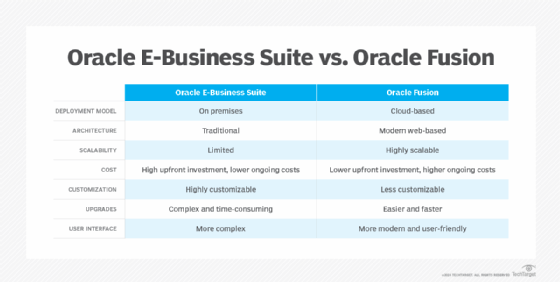Oracle E-Business Suite
What is Oracle E-Business Suite?
Oracle E-Business Suite is one of Oracle Corporation's major product lines. First released in 2001, E-Business Suite was Oracle's first full bundle of enterprise resource planning (ERP) and customer relationship management (CRM) applications. It remains the most widely used line of business applications in the company's product portfolio. Oracle E-Business Suite applications run on top of the vendor's flagship Oracle Database software.
Despite the release of Oracle Fusion Applications in 2011, which combine various functions and features from Oracle E-Business Suite, JD Edwards, PeopleSoft and Siebel products, Oracle continues to actively update and support E-Business Suite and will continue to do so for the foreseeable future.
Like rival offerings from vendors such as SAP, Microsoft, Workday and Infor, Oracle E-Business Suite was designed to help users manage global businesses, improve decision-making, reduce costs and improve corporate performance. E-Business Suite contains application modules that support different aspects of CRM, ERP and supply chain management (SCM) operations, including customer service management, financial management, human capital management, project portfolio management, procurement, and value chain planning and execution. Oracle also has pre-integrated its business intelligence applications with E-Business Suite to give users BI and analytics capabilities.
What E-Business Suite includes
E-Business Suite is an integrated set of business applications for automating CRM, ERP and SCM processes.
Other core functions and features include human capital management, asset lifecycle management, order management, procurement, project portfolio management, and business intelligence and analytics. Depending on the version, advanced modules include Advanced Procurement, Value Chain Planning and Value Chain Execution.
How E-Business Suite compares to Oracle Fusion
Oracle E-Business Suite and Oracle Fusion -- or Oracle Fusion Applications -- are both comprehensive business application suites. The key differences lie in their architectures and use cases. E-Business Suite is essentially a traditional, on-premises solution with legacy architecture. On the other hand, Oracle Fusion is a modern, cloud-based solution that boasts enhanced flexibility. Figure 1 compares the

Which option is best for an organization depends on current infrastructure, business needs and goals. E-Business Suite is perfect for enterprises that require a highly customizable system that can be controlled completely. Fusion is better for companies looking for a user-friendly, more modern system.
Implementing E-Business Suite
Here are the basic steps to using E Business Suite:
- Understanding business requirements. Identify which business processes and functions E-Business Suite will manage. This helps determine which modules -- e.g., supply chain, finance, human resources -- the business will use.
- Installation and configuration. Install the Oracle E-Business Suite software on premises or in the cloud, and configure each module based on your unique business processes. Set up parameters, define workflows, and customize forms and reports. During installation and configuration, migrating existing data from legacy systems to E-Business Suite is important. This can include information like employee records, customer information, inventory, financial data and more. It's vital to ensure data integrity and accuracy during the migration.
- Integration. Integrate E-Business Suite with other Oracle applications and current business systems, such as CRM systems, third-party applications and external databases.
- Accessing E-Business Suite. Set up a username and password for system access. With its many menus, buttons and icons, the E-Business Suite interface can be overwhelming for first-time users. However, you only use specific features required by your particular role with assigned tasks and permissions. So, it is crucial to first know your responsibilities and the tasks you're authorized to perform.
E-Business Suite training
Oracle offers various training resources, including online tutorials, instructor-led courses and user guides, to help new E-Business Suite users get comfortable.
E-Business Suite R12
Released in 2012, Oracle E-Business Suite R12 introduced new features and enhancements, including improved social collaboration tools, enhanced mobile capabilities and easier integration with Oracle's suite of cloud-based applications. Although Oracle has released newer versions of E-Business Suite, E-Business Suite R12 is still used extensively.
E-Business Suite Financials
E-Business Suite Financials is software designed specifically to manage financial activities. This suite hosts several finance-focused E-Business Suite modules and applications, including General Ledger, Payables, Receivables and Cash Management. Highly scalable to serve the needs of businesses of all sizes, E-Business Suite Financials helps improve accuracy, efficiency, compliance and visibility in financial performance.
Understand the differences between CRM vs. ERP. Explore ERP use cases to consider before buying an ERP system. Check out our comprehensive guide to supply chain management.







